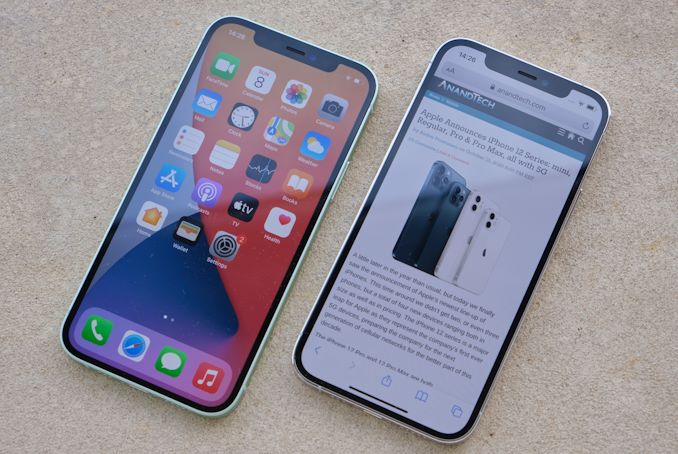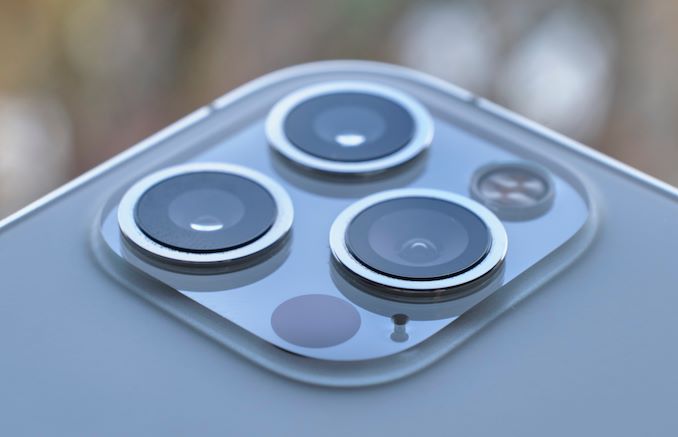The iPhone 12 & 12 Pro Review: New Design and Diminishing Returns
by Andrei Frumusanu on November 30, 2020 8:30 AM EST- Posted in
- Mobile
- Apple
- Smartphones
- Apple A14
- iPhone 12
- iPhone 12 Pro
Conclusion & End Remarks
We’ve had the new iPhones for a few weeks now, admittedly pushing out this review in favour of coverage of Apple’s newest Apple Silicon M1 devices. As I’m finally finishing up this iPhone review, the one feeling I have is that I’m not all too excited for this new generation of phones, with several factors coming into play.
First of all, design-wise, the new iPhone 12 series are definitely a breath of fresh air for Apple’s device line-up. Finally dropping the industrial design look that was adopted 3 years ago by the iPhone X, the new iPhone 12’s design is a mix of the old and new. There’s undoubtedly homage to the iPhone 4 and 5 era which featured also featured flat metal frames in their design, and it does make the iPhone 12 series stand out versus any other phone today.
Whilst design and looks are one side of the coin, the other side is actual usability and ergonomics. In this regard, I’m just not a very big fan of Apple’s choices here as I outright feel the iPhone 12s are a step backwards compared to the iPhone 11 series. Although the width of the phones isn’t any larger on the new models, they just feel noticeably bigger in the hand due to the right-angle frame edges. I ask myself as what exactly was the reason in the first place that over the years, we transitioned to rounded phones, with various vendors investing into curved front and back glass devices, if it was not for the benefit of better ergonomics, and for the devices to fit better in our fleshy meat hands. I mean, what’s the point in making the new iPhones thinner, and lose out on battery capacity, if they don’t actually feel thinner in the hand? I know it’s a very subjective topic and people might not have the same strong opinion, but even after a few weeks I still prefer to go back to an iPhone 11 Pro because of the more natural ergonomics.
Build-quality wise, the new iPhones are great and feel extremely solid. I prefer the aluminium iPhone 12 over the steel 12 Pro due to it not collecting fingerprints and actually being much lighter, although the frosted matte glass back panel of the 12 Pro definitely has the much better feeling finish.
The displays of the iPhone 12’s are good, with the Pro devices having the better quality displays of the series, having a higher brightness and better viewing angles, although the practical differences between the two models aren’t all that great.
The fact that both the iPhone 12 and 12 Pro have the same resolution OLED displays this generation means that the feature differences this year are far smaller compared to last year’s iPhone 11 vs 11 Pro juxtaposition. This is a major change in the product line-up that in my opinion makes the lower-end variants significantly more interesting and more viable versus the more expensive Pro-counterparts.
The lack of a higher refresh-rate display option is a pity, but given the battery impact on other devices on the market, it might have been wise for Apple to hold this feature back until the technology has matured enough to ensure a non-negative user experience. As it stands, the battery life of the iPhone 12 and 12 Pro is in line with last year’s 11 Pro – which is excellent.
Performance of the new iPhone 12’s is both a strength-point as well as a weakness. The strength is that the new A14 chip is by far the best performing mobile SoC on the market right now. The weakness is, that compared to the A13, the generational improvements aren’t as great as prior A-series SoC jumps. In every-day usage, I’m sure the iPhone 12s are faster than the iPhone 11 devices, but I’d be hard-pressed to actually notice this without a side-by-side comparison. This includes CPU-side use-cases as well as GPU-side gaming use-cases, which see an even smaller generational upgrade.
On the camera side, Apple has kept the base formula of the iPhone 11 series, and resorted to smaller generational improvements. The largest improvement is a new HDR algorithm that is actually quite noticeable in daylight shots, and produces better tone-mapping and contrast-rich pictures. The ultra-wide-angle module especially sees much better image processing with more details. Oddly enough, the telephoto module on the 12 Pro has been consistently worse than the 11 Pro in our testing, with far less detail retention.
In low-light, the camera’s new f/1.6 aperture does allow for slightly better light capture, however the general processing and Night Mode doesn’t seem to have been changed much this generation. The ultra-wide-angle’s added capability of Night Mode means that it’s not completely useless in low-light, although it’s not quite as high quality as competitor solutions.
While I’m relatively happy with the camera experience, I feel like Apple didn’t quite push the boundaries as far as they could have. The competition both has better hardware, and has made huge strides in terms of computational photography and image processing, and there’s just better phone cameras out there right now.
Good Improvements, Although Not Very Exciting
I have two verdicts for the iPhone 12’s, one for the 12 Pro and one for the regular iPhone 12.
For the iPhone 12 Pro, unless you’re coming from an older-generation device, there’s very few selling-points compared to the iPhone 11 Pro. The screen is slightly better, the cameras are slightly better, and it’s posting slightly better performance. Battery life being the same and the ergonomics being arguable, that only leaves 5G as the major unique feature of the new device. At this stage of 5G deployment, whether a 5G-compatible device is worth the upgrade for you is going to be highly dependent on your location and carrier. At $999 or 1159€ I feel that the phone should have offered something more to make the choice easier.
The iPhone 12, on the other hand, is in my opinion Apple’s best iPhone in a very long time. At $799 / 909€, the only real tangible thing you’re losing out on versus the Pro is the telephoto module. You’re still getting an excellent screen, the same performance, almost identical battery life, and otherwise identical everyday camera experience for $200 less. Even though it’s $100 more expensive than the iPhone 11, the much better screen elevates it into a better tier-category. The fact that it’s a lighter phone and fingerprint resistant aluminium is actually a plus in my book.
The iPhone 12 mini and 12 Pro Max are still open for debate as we didn’t have a chance to review them yet. If you’re looking for a small phone, the 12 mini looks like a perfect device, while if you’re looking for a max-sized phone and don’t mind the larger price-tag, the 12 Pro Max also certainly going to be a good option, especially if the new camera module hardware pans out.












101 Comments
View All Comments
anshelanancy - Wednesday, December 2, 2020 - link
This iPhone 12 is really well designed but high cost and released in some countries normally we can buy it online. I want to buy this but it isn't released in my country. I must buy this phone but this time I am so much busy with my office work https://accountancyseekers.co.uk/ here doing work as a marketing executive since 2017.Byte - Tuesday, December 15, 2020 - link
I kept my X to play games on and found it hurts to hold the X now because the the whole side feels sharp now. Am i weird?Laga Goteborg - Thursday, June 24, 2021 - link
iPhone 12 LCD screens are much tougher than before, we had cases that glass was intact but LCD under glass was shattered. However we could always fix the problem via https://www.LagaiPhone.se/KPOM - Monday, November 30, 2020 - link
The 12 mini hits the sweet spot for design and features this year, and I’m surprised it isn’t selling better (apparently Apple is seeing more demand than expected for the Pro and Max and somewhat less for the 12 and mini).I agree that the 12 Pro is a bit heavy and the new design isn’t as easy to hold as the 11 Pro. But the mini is only slightly bigger than the original iPhone SE/5/5s, and is the most comfortable phone to hold that I’ve seen in years.
Bob Todd - Monday, November 30, 2020 - link
I assume some of it is just that people have gotten accustomed to gargantuan phones over time and it can be a bit of a shock to scale back down. After holding the 12 mini in one hand and my OnePlus 6 in the other, I was certainly hesitant to give up that much screen. It was mostly fond memories of my Essential Phone's form factor that pushed me to choose the mini. My wife on the other hand is eyeing the regular 12 for this exact reason. She's accustomed to the size of her OnePlus 7T and the progressively larger phones that have landed her there.lmcd - Tuesday, December 1, 2020 - link
I personally think that it's due to upgrade cycle timing -- why buy a 12 mini if you just bought an SE 2020?I think a lot of people in that niche picked up an SE and also are already the type to hold onto their phones longer.
techconc - Monday, December 7, 2020 - link
Agreed. I have the 12 Pro, but after feeling the 12 mini in my hand (and in my pocket), I think I may go mini next time.ikjadoon - Monday, November 30, 2020 - link
The Mini is limited to 12W peak MagSafe, unlike “up to 15W” on all the other models.https://support.apple.com/en-us/HT211829
Jetcat3 - Monday, November 30, 2020 - link
12W peak with a 2227 mAh cell is non issue in my opinion.Andrei, in your testing did you notice increased black levels with low APL’s at brightness levels between 0-40%?
ikjadoon - Monday, November 30, 2020 - link
I don't think a single person genuinely cares or notices peak charging rates: minutes at best? Though the first page chart is a little incorrect.On displays, I'd be much more interested in power consumption of the two panels, so we can compare with the 11 Pro.